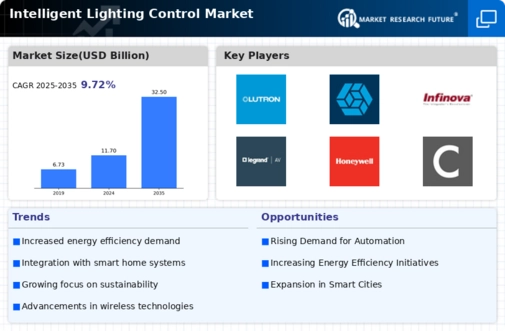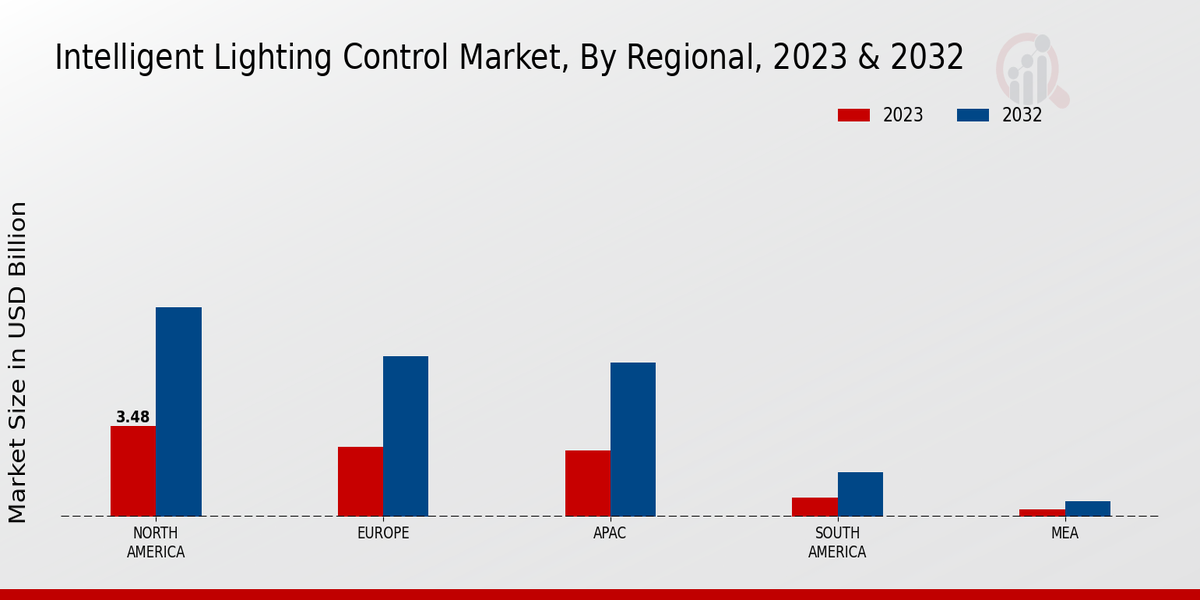Market Growth Projections
The Global Intelligent Lighting Control Market Industry is poised for substantial growth, with projections indicating a market size of 11.7 USD Billion in 2024 and an anticipated increase to 32.5 USD Billion by 2035. This growth trajectory suggests a compound annual growth rate of 9.73 percent from 2025 to 2035, reflecting the increasing adoption of intelligent lighting solutions across various sectors. The market's expansion is driven by factors such as technological advancements, government initiatives, and the rising demand for energy-efficient systems.
Technological Advancements in IoT
The integration of Internet of Things (IoT) technology into lighting systems is a key driver for the Global Intelligent Lighting Control Market Industry. IoT-enabled lighting solutions allow for real-time monitoring and control, enhancing user experience and operational efficiency. For instance, smart lighting systems can adjust brightness based on occupancy and natural light levels, which optimizes energy use. As IoT technology continues to evolve, it is expected to propel the market forward, with projections indicating a growth to 32.5 USD Billion by 2035, showcasing the transformative potential of these advancements.
Growing Demand for Energy Efficiency
The Global Intelligent Lighting Control Market Industry experiences a robust demand for energy-efficient solutions, driven by rising energy costs and environmental concerns. Intelligent lighting systems, which include smart sensors and automated controls, can reduce energy consumption by up to 30 percent. This shift towards energy efficiency is not only economically beneficial but also aligns with global sustainability goals. As cities and businesses seek to minimize their carbon footprints, the market is projected to reach 11.7 USD Billion in 2024, reflecting a significant investment in intelligent lighting technologies.
Rising Urbanization and Smart Cities
Urbanization trends are significantly influencing the Global Intelligent Lighting Control Market Industry. As more people migrate to urban areas, the demand for smart city solutions, including intelligent lighting, is on the rise. Smart lighting systems enhance public safety, reduce energy costs, and improve the overall quality of urban life. Cities worldwide are investing in these technologies to create more livable environments. This trend is expected to drive the market's expansion, as urban areas increasingly adopt intelligent lighting solutions to meet the needs of growing populations.
Government Initiatives and Regulations
Government policies promoting energy conservation and sustainability are pivotal in shaping the Global Intelligent Lighting Control Market Industry. Various countries have implemented regulations that mandate the use of energy-efficient lighting solutions in commercial and residential buildings. For example, initiatives such as tax incentives for energy-efficient upgrades encourage the adoption of intelligent lighting systems. These regulatory frameworks not only foster market growth but also contribute to achieving national and international energy reduction targets. As a result, the market is likely to experience a compound annual growth rate of 9.73 percent from 2025 to 2035.
Increased Focus on Safety and Security
The emphasis on safety and security in public and private spaces is a crucial driver for the Global Intelligent Lighting Control Market Industry. Intelligent lighting systems equipped with motion sensors and adaptive controls enhance visibility and deter crime, making environments safer. For instance, smart street lighting can automatically adjust brightness based on pedestrian activity, thereby improving safety in urban areas. This focus on security is likely to propel the adoption of intelligent lighting solutions, as stakeholders recognize the value of investing in technologies that enhance public safety.














